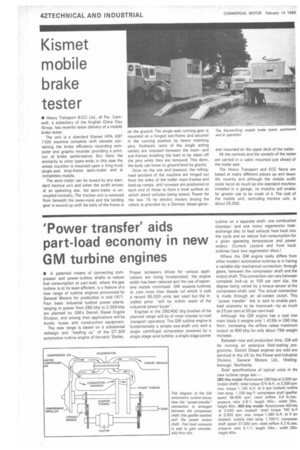' Power transfer' aids part-load economy in new GM turbine engines
Page 44

If you've noticed an error in this article please click here to report it so we can fix it.
• A patented means of connecting compressor and power-turbine shafts to reduce fuel consumption at part-load, where the gas turbine is at its least efficient, is a feature of a new range of turbine engines announced by General Motors for production in mid-1971. Four basic industrial turbine power plants, ranging in power from 280 bhp to 2,000 bhp are planned by GM's Detroit Diesel Engine Division, and among their applications will be trucks, buses and construction equipment.
The new range is based on a substantial redesign and "beefing up" of the GT-309 automotive turbine engine of the early 'Sixties. Proper accessory drives for various applications are being incorporated, the engine width has been reduced and the use of expensive metals minimized. GM expects turbines to cost more than diesels (of which it sold a record 95,000 units last year) but the installed price "will be within reach of the industrial power buyer".
Engihes in the 280/400 bhp bracket of the planned range will be of most interest to road transport operators. The GM turbine engine is fundamentally a simple two-shaft unit with a single centrifugal compressor powered by a single-stage axial turbine: a single-stage power turbine on a separate shaft; one combustion chamber: and one rotary regenerator heatexchange disc to feed exhaust heat back into the cycle and so reduce fuel consumption for a given operating temperature and power output. (Current Leyland and Ford truck turbines have two regenerator discs.) Where the GM engine really differs from other modern automotive turbines is in having a variable-slip mechanical connection, through gears, between the compressor shaft and the output shaft. This connection can vary between complete lock-up or 100 per cent slip, the degree being varied by a torque sensor at the compressor-shaft end. The actual connection is made through an oil cooled clutch. This "power transfer" link is said to enable partload economy to be improved—by as much as 25 per cent at 50 per cent load.
Although the GM engine has a cast iron main block it weighs only 1,425Ib in 280 bhp form; increasing the airflow raises maximum output to 400 bhp for only about 75Ib weight increase.
Between now and production time, GM will be running an extensive field-testing programme. Detroit Diesel engines are sold and serviced in the UK by the Power and Industrial Division, General Motors Ltd., Wellingborough, Northants.
Brief specifications of typical units in the new turbine range are:
280 bhp model: Rated power 280 bhp at 3,000 rprr (output shaft); rated torque 575 lb.ft. at 3.000 rpm max. torque 1.150 b.ft. at 0 rpm (stalled); turbine inlet temp. 1,700 deg F: compressor shaft (gasifier speed 36,000 rpm: rated airflow 3.9 Ibisec, pressure ratio 3.8:1; length 45in.; width 26in. height 40in. 400 bhp model: Rated power 400 bhr at 3,000 rpm loutputl: rated torque 790 lb.ft at 3,000 rpm: max. torque 1,580 lb.ft. at 0 rpn (stalled): turbine inlet temp 1,700"F: compressc shaft speed 37.000 rpm: rated airflow 5.2 lb./sec. pressure ratio 5.1:1; length 54in.: width 26in. height 40m.


















































































































